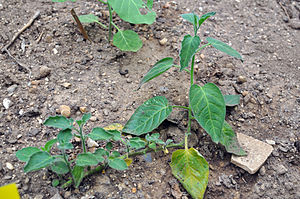Solanum trisectum
| Solanum trisectum | ||||||||||||
|---|---|---|---|---|---|---|---|---|---|---|---|---|

Solanum trisectum |
||||||||||||
| Systematics | ||||||||||||
|
||||||||||||
| Scientific name | ||||||||||||
| Solanum trisectum | ||||||||||||
| Dunal |
Solanum trisectum (Syn .: Normania triphylla ) is a species of the nightshade genus ( Solanum ) inthe nightshade family (Solanaceae). The species is a very rare endemic species that isonly known from northern Madeira .
description
Vegetative characteristics
Solanum trisectum is an herbaceous plant or subshrub with a height of up to 1 m. The stems grow upright, have a diameter of about 5 mm, are hollow, green in color and densely hairy with about 0.5 mm long, glandular trichomes . The glandular heads of the trichomes consist of a single cell. A sympodial unit consists of three, four or more leaves and internodes .
The leaves are 4 to 8 cm long and 2 to 9 cm wide. They are three-lobed or three-part, sometimes only a single basal lobe is formed, especially in the upper area of the plant, or the leaves are unlobed. The side lobes are about 8 × 5 cm in size and elliptical in shape, the middle lobe is similar in size, but egg-shaped and has its widest point approximately in the middle. The top and bottom are densely hairy with glands. In addition to the glandular hairs, there are a few simple trichomes up to 1 mm long on the upper side; on the upper side these are mainly on the leaf veins. The base of the leaves is cut off or, if they are not lobed, heart-shaped, the leaf margin is entire or weakly toothed and ciliate with dense glandular lashes, towards the front they are pointed to pointed. The leaf stalks are 1.5 to 5 cm long and have densely glandular hairs.
Inflorescences and flowers
The inflorescences arise from the internodes, directly below the leaves, they are more densely packed at the top of the plant. They are 2.5 to 8 cm long, are undivided and consist of six to nine flowers . The inflorescence stalks are 0.5 to 2 cm long. The inflorescence axes are densely covered with undivided, glandular trichomes. The slender flower stalks stand 0.5 to 1 cm apart and are about 1 to 1.3 cm long at flowering time, measure about 1 mm in diameter and stand upright. They are densely covered with 1 to 2 mm long, glandular trichomes.
The flowers have a broad, cup-shaped calyx that is 2 to 3 mm long and is covered with 5 to 6 mm long, narrow elliptical calyx tips that point towards the front. They are sparsely hairy on the outside with simple, single-row trichomes with a length of up to 2 mm, on the inside they are hairy glandular. The crown measures 3 to 3.5 cm in diameter and is pale purple in color. The corolla lobes are only about 1 mm long and finely triangular. They are flat or slightly curved back at flowering time. The edge and the tips of the corolla lobes are densely papillary .
The anthers are yellow and come in three different sizes: the two longest are 7 to 9 mm long, the two middle ones are 5 to 6 mm long and the smallest anthers are about 3 mm long. All anthers are about 1 to 1.5 mm wide. They open through pores at the tips, which later lengthen into slits. The long and medium anthers have a horn-shaped extension that is about 1 mm long and 2 to 4 mm above the base of the anthers. The stamens are finely hairy with glandular hair and fused to about 1 mm to form a tube, the free-standing part is 2 to 3 mm long. The ovary is hairless and conical in shape. It has a stylus , 0.7 to 0.8 cm long , which is strongly curved upwards and ends in a fine, cephalic and papillary scar .
Fruits and seeds
When the fruit ripens, the flower stalks are enlarged to a diameter of 1 mm and a length of 1 to 1.5 mm, not noticeably lignified and slightly nodding. The chalice is enlarged and protruding. The fruit is a flattened, spherical berry with a diameter of 1 to 1.5 cm. When ripe it is reddish orange or red in color and has a thin pericarp . The seeds are 5 × 4 mm in size, egg-shaped and dark reddish-brown. The edges are irregularly notched, the surface is finely grained. The cells of the Testa have straight cell walls.
Occurrence
The species is a very rare endemic, the only known location is in a laurisilva (laurel forest) in northern Madeira .
Systematics
Solanum trisectum is classified within the nightshade ( Solanum ) in the Normania clade comprising only three species. The species of the clade were listed as two separate genera for a long time, Solanum trisectum and Solanum nava formed as Normania triphylla and Normania nava the genus Normania and Solanum herculeum the genus Triguera (as Triguera osbeckii ).
proof
- Sandra Knapp: Solanum trisectum . In: Solanaceae Source ( online ), July 2006, accessed February 20, 2011.